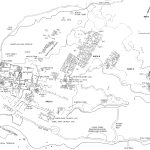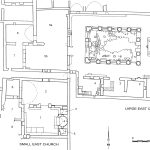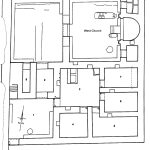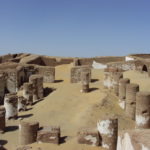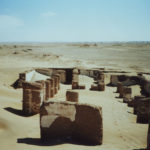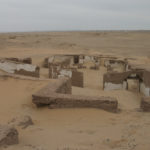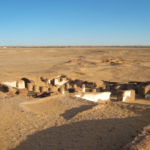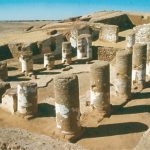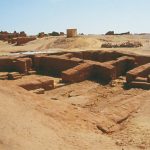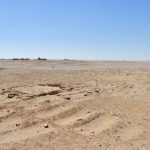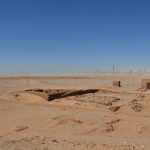ISMANT AL-ḪARĀB (KELLIS)
| Egyptian | Qjl.t |
| Greek | Κελλις |
| Coptic | qlle | qhla | qhlh | gwlwle |
| Arabic | إسمنت الخراب |
| English | Ismant el-Kharab | Asmant el-Kharab | Ismant el-Gharab |
| French | Asmant el-Kharab | el-Smant el-Kharab | Ismant el-Gharab | Sment el-Kharab | Smint el-Kharâb |
| DEChriM ID | 12 |
| Trismegistos GeoID | 2762 |
| Pleiades ID | 776189 | PAThs ID | 114 |
| Ancient name | Kellis |
| Modern name | Ismant al-Ḫarāb |
| Latitude | 25.515315 |
| Longitude | 29.096663 |
| Date from | 50 |
| Date to | 393 |
| Typology | Village |
| Dating criteria | |
| Description | "Kellis (modern Ismant al-Ḫarāb) is located in the Dakhla Oasis of Upper Egypt, ca. 2.5 km southeast of the village of Ismant and ca. 11 km northeast of Mūt, the capital of the oasis. The site, which is considerably widespread, is surrounded to the south and west –at a certain distance– by cultivated fields and to the northwest and southeast by dried up canals. - Nicola Aravecchia |
| Archaeological research | The first investigations of Ismant al-Ḫarāb were conducted by the Dakhleh Oasis Project (DOP), in 1981-2. After this, proper excavations began in 1986 under the direction of Colin A. Hope, supported by Monash University. These excavations continued until 2010. |
• Abd Elsalam, H. 2011. “Using Geographic Information Systems (GIS) in Spatial Analysis of Mortuary Practices in the Kellis 2 Cemetery, Dakhleh Oasis, Egypt.“ MA Thesis, University of Central Florida.
• Alcock, A. and I. Gardner. 1999. “The Coptic Economic Texts from Kellis (Dakhleh Oasis).” In Ägypten und Nubien in Spätantiker und Christlicher Zeit 2: Akten des 6. Internationalen Koptologenkongresses Münster, 20.-26. Juli 1996, edited by S. Emmel, M. Krause, S. G. Richter and S. Schaten, 231-238. Wiesbaden: Reichert Verlag.
• Alcock, A., I. Gardner and P. Mirecki. 1997. “Magical Spell, Manichaean Letter.” In Emerging from Darkness to Light, edited by P. Mirecki and J. BeDuhn, 1-32. Leiden: Brill.
• Aravecchia, N. 2015. “Christianity at Trimithis and in the Dakhla Oasis.” In An Oasis City, edited by R. S. Bagnall, N. Aravecchia, R. Cribiore, P. Davoli, O. E. Kaper and S. McFadden, 119-148. New York: NYU Press.
• Aufderheide, A. C., L. Cartmell and M. Zlonis. 2003. “Bio-anthropological Features of Human Mummies in Kellis 1 Cemetery: The Database for Mummification Methods.” In The Oasis Papers 3: Proceedings of the Third International Conference of the Dakhleh Oasis Project, edited by G. E. Bowen and C. A. Hope, 137-151. Oxford: Oxbow Books.
• Aufderheide, A. C. L. Cartmell, M. Zlonis and P. Sheldrick. 2004. “Mummification Practices at Kellis Site in Egypt’s Dakhleh Oasis.” Journal of the Society for the Study of Egyptian Antiquities 31: 63-77.
• Aufderheide, A. C., M. Zlonis, L. Cartmell, M. R. Zimmerman, P. Sheldrick, M. Cook and J. E Molto. 1999. “Human Mummification Practices at Ismant el-Kharab.” Journal of Egyptian Archaeology 85: 193-210.
• Bagnall, R. S., ed. 1997. The Kellis Agricultural Account Book. Oxford: Oxbow Books.
• Bagnall, R. S. 1999. “The Date of P. Kell. I G. 62 and the Meaning of χωριον.” Chronique d’Égypte 74: 329-333.
• Bagnall, R. S. 2008. “Economy and Ecology in the Kellis Agricultural Account Book.” In The Oasis Papers 2: Proceedings of the Second International Conference of the Dakhleh Oasis Project, edited by Marcia F. Wiseman, 115-118. Oxford: Oxbow Books.
• Bagnall, R. S., U. Thanheiser and K. A. Worp. 1989. “Tiphagion.” Zeitschrift für Papyrologie und Epigraphik 122: 173-181.
• Bagnall, R. S. and K. A. Worp. 2000a. “ΤΕΤΡΑΧΡΥΣΟΝ.” Tyche: Beiträge zur Alten Geschichte, Papyrologie und Epigraphik 15: 3-6.
• Bagnall, R. S. and K. A. Worp. 2000b. “Two 4th Century Accounts from Kellis.” In Papyri in honorem Johannis Bingen Octogenarii, edited by H. Malaerts, 495-509. Leuven: Peeters.
• Bagnall, R. S. and K. A. Worp, 2002. “An Inscribed Pedestal from the Temple of Tutu.” In Dakhleh Oasis Project: Preliminary Reports on the 1994-1995 to 1998-1999 Field Seasons, edited by C. A. Hope and G. E. Bowen, 49-51. Oxford: Oxbow Books.
• Bagnall, R. S. and K. A. Worp. 2011. “Family Papers from Second-Century A.D. Kellis.” Chronique d’Égypte 86: 228-253.
• Berry, M. 1999. “A Study of Pigments from a Roman Egyptian Shrine.” Australian Institute for the Conservation of Cultural Materials Bulletin 24: 1-9.
• Berry, M. 2002. “The Study of Pigments from Shrine I at Ismant el-Kharab.” In Dakhleh Oasis Project: Preliminary Reports on the 1994-1995 to 1998-1999 Field Seasons, edited by C. A. Hope and G. E. Bowen, 53-60. Oxford: Oxbow Books.
• Birrell, M. 1999. “Excavations in the Cemeteries of Ismant el-Kharab.” In Dakhleh Oasis Project: Preliminary Reports on the 1992-1993 and 1993-1994 Field Seasons, edited by C. A. Hope and A. J. Mills, 29-42. Oxford: Oxbow Books.
• Bleuze, M. M., S. M. Wheeler, T. L. Dupras, L. J. Williams and J. E. Molto. 2014. “An Exploration of Adult Body Shape and Limb Proportions at Kellis 2, Dakhleh Oasis, Egypt.” American Journal of Physical Anthropology 153: 496-505.
• Blondaux, L. 2002. “Conservation of Archaeological Wall Paintings in the Temple of Tutu.” In Dakhleh Oasis Project: Preliminary Reports on the 1994-1995 to 1998-1999 Field Seasons, edited by C. A. Hope and G. E. Bowen, 61-63. Oxford: Oxbow Books.
• Blondaux. L. 2008. “Conservation at Ismant el-Kharab: Examples of Wall Painting in Shrine I.” In The Oasis Papers 2: Proceedings of the Second International Conference of the Dakhleh Oasis Project, edited by Marcia F. Wiseman, 151-152. Oxford: Oxbow Books.
• Bowen, G. E. 1998. "The Spread of Christianity in Egypt in Light of Recent Discoveries from Ancient Kellis." PhD Thesis, Monash University.
• Bowen, G. E. 1999a. “The Coinage: A Preliminary Report.” In Dakhleh Oasis Project: Preliminary Reports on the 1992-1993 and 1993-1994 Field Seasons, edited by C. A. Hope and A. J. Mills, 43-47. Oxford: Oxbow Books.
• Bowen, G. E. 1999b. “Textiles from Ismant el-Kharab.” Bulletin of the Australian Centre for Egyptology 10: 7-12.
• Bowen, G. E. 2000. “The Small Church at Ismant el-Kharab.” Bulletin of the Australian Centre for Egyptology 11: 29-34.
• Bowen, G. E. 2001a. “Texts and Textiles: A Study of the Textile Industry at Ancient Kellis.” The Artefact 24: 18-28.
• Bowen, G. E. 2001b. “A Suggested Interpretation of the Coin-Finds of Ismant el-Kharab.” In Oasis Papers 1: The Proceedings of the First Conference of the Dakhleh Oasis Project, edited by C. A. Marlow and A. J. Mills, 60-64. Oxford: Oxbow Books.
• Bowen, G. E. 2002a. “The Fourth Century Churches at Ismant el-Kharab.” In Dakhleh Oasis Project: Preliminary Reports on the 1994-1995 to 1998-1999 Field Season, edited by C. A. Hope and G. E. Bowen, 65-85. Oxford: Oxbow Books.
• Bowen, G. E. 2002b. “Textiles, Basketry and Leather Goods from Ismant el-Kharab.” In Dakhleh Oasis Project: Preliminary Reports on the 1994-1995 to 1998-1999 Field Seasons, edited by C. A. Hope and G. E. Bowen, 87-104. Oxford: Oxbow Books.
• Bowen, G. E. 2003a. “The Small East Church at Ismant el-Kharab.” In The Oasis Papers 3: Proceedings of the Third International Conference of the Dakhleh Oasis Project, edited by G. E. Bowen and C. A. Hope, 153-165. Oxford: Oxbow Books.
• Bowen, G. E. 2003b. “Some Observations on Christian Burial Practices at Kellis.” In The Oasis Papers 3: Proceedings of the Third International Conference of the Dakhleh Oasis Project, edited by G. E. Bowen and C. A. Hope, 167-181. Oxford: Oxbow Books.
• Bowen, G. E. 2003c. “The Small East Church at Ismant el-Kharab.” In The Oasis Papers 3: Proceedings of the Third International Conference of the Dakhleh Oasis Project, edited by G. E. Bowen and C. A. Hope, 153-165. Oxford: Oxbow Books.
• Bowen, G. E. 2003d. “Early Christian Burial Practices at Kellis, Dakhleh Oasis, Egypt.” The Artefact 26: 77-88.
• Bowen, G. E. 2004. “Aspects of Christian Burial Practice.” Buried History 40: 15-28.
• Bowen, G. E. 2007. “Coin Hoards: 57. Ismant el-Kharab, Ancient Kellis, in Dakhleh Oasis.” The Numismatic Chronicle 167: 260 – 263.
• Bowen, G. E. 2010. “Excavation Coins: Coins from the 4th Century Churches and Christian Cemetery at Ismant el-Kharab, Dakhleh Oasis, Egypt.” The Numismatic Chronicle 170: 457 – 483.
• Bowen, G. 2012a. “Child, Infant and Foetal Burials of the Late Roman Period at Ismant el-Kharab, Ancient Kellis, Dakhleh Oasis.” In L’Enfant et la mort dans l’Antiquité II, edited by M.-D. Nenna, 351–372. Alexandria: Centre d’études alexandrines.
• Bowen, G. 2012b. “Coins as Tools for Dating the Foundation of the Large East Church at Kellis: Problems and a Possible Solution.” In The Oasis Papers 6, edited by R.S. Bagnall, P. Davoli and C.A. Hope, 417-428. Oxford: Oxbow Books.
• Bowen, G. 2014. “The Crux Ansata in Early Christian Iconography: Evidence from Dakhleh and Kharga Oases.” In Le Myrte et la rose: Mélanges offerts à Françoise Dunand par ses élèves, collègues et amis, edited by G. Tallet and C. Zivie-Coche, 292-303. Montpellier: Université Paul Valéry, CNRS.
• Bowen, G. 2015. “The Environment Within: the Archaeological Context of the Texts from House 3 at Kellis in Egypt’s Dakhleh-Oasis.” In Housing and Habitat in the Ancient Mediterranean World: Cultural and Environmental Responses, edited by A. A. Di Castro and C.A. Hope, 231-241. Leuvan: Peeters.
• Bowen, G. 2016. “A 4th Century AD Hoard from Ayn al-Sebil, Dakhleh Oasis Egypt.” Numismatic Chronicle 176: 355–358.
• Bowen, G. 2022. “The Churches”. In Kellis: A Roman Period Village in Dakhleh Oasis, edited by C. A. Hope and G. E. Bowen, 269-288. Cambridge: Cambridge University Press.
• Bowen, G. E., T. Chandler, C. A. Hope and D. Martin. 2006. “Reconstructing Ancient Kellis Part II.” Buried History 42: 17-24.
• Bowen, G. E., T. Chandler and D. Martin. 2005. “Reconstructing Ancient Kellis.” Buried History 41: 51-64.
• Bowen, G. E., W. Dolling, C. A. Hope and P. Kucera. 2007. “Brief Report on the 2007 Excavations at Ismant el-Kharab.” Bulletin of the Australian Centre for Egyptology 18: 21-52.
• Bowen, G. E. and C. A. Hope. 1997. “The Excavations at Ismant el-Kharab in 1995/6 and 1996/7: A Brief Report.” Bulletin of the Australian Centre for Egyptology 8: 49-64.
• Bowen, G. E., C. A. Hope and O. E. Kaper. 1993. “A Brief Report on the Excavations at Ismant el-Kharab in 1992-1993.” Bulletin of the Australian Centre for Egyptology 4: 17-28.
• Bowen, G. E., T. Chandler, C. A. Hope and D. Martin. 2006. “Reconstructing Ancient Kellis Part II.” Buried History 42: 17-24.
• Chase, G. L. 2018. “Investigations of Possible Cases of Scurvy in Juveniles from the Kellis 2 Cemetery in the Dakhleh Oasis, Egypt, through Stable Carbon and Nitrogen Isotope Analyis of Multiple Tissues.“ MA Thesis, University of Central Florida.
• Churcher, C. S. 2002. “Faunal Remains from Kellis.” In Dakhleh Oasis Project: Preliminary Reports on the 1994-1995 to 1998-1999 Field Seasons, edited by C. A. Hope and G. E. Bowen, 105-113. Oxford: Oxbow Books.
• Cole, K. 2012. “Intrinsic Factors Affecting Decomposition Changes in Archaeological Head Hair from Kellis 2 Cemetery, Dakhleh Oasis, Egypt.“ MA Thesis, University of Central Florida.
• Connor, A. 2022. “Administration”. In Kellis: A Roman Period Village in Dakhleh Oasis, edited by C. A. Hope and G. E. Bowen, 169-184. Cambridge: Cambridge University Press.
• Coombs, C. E., A. L. Woodhead and J. S. Church. 2002. “Report on the Characterization of Three Fabric Samples from Ismant el-Kharab.” In Dakhleh Oasis Project: Preliminary Reports on the 1994-1995 to 1998-1999 Field Seasons, edited by C. A. Hope and G. E. Bowen, 115-119. Oxford: Oxbow Books.
• de Jong, T. and K. A. Worp. 1995. “A Greek Horoscope from 373 A.D.” Zeitschrift für Papyrologie und Epigraphik 106: 235-240.
• de Jong, T. and K. A. Worp. 2001. “More Greek Horoscopes from Kellis (Dakhleh Oasis).” Zeitschrift für Papyrologie und Epigraphik 137: 203-214.
• Dobrowolski, J. 2002. “Remarks on the Construction Stages of the Main Temple and Shrines I-II.” In Dakhleh Oasis Project: Preliminary Reports on the 1994-1995 to 1998-1999 Field Seasons, edited by C. A. Hope and G. E. Bowen, 121-128. Oxford: Oxbow Books.
• Dubois, J. -D. 2013. “Greek and Coptic Documents from Kellis. A Contribution to the History of a Manichaean Community.” Journal of Coptic Studies 15: 21-8.
• Dunsmore, A. 2002. “Ceramics from Ismant el-Kharab.” In Dakhleh Oasis Project: Preliminary Reports on the 1994-1995 to 1998-1999 Field Seasons, edited by C. A. Hope and G. E. Bowen, 129-142. Oxford: Oxbow Books.
• Dupras, T. L. and M. W. Tocheri. 2003a. “A Preliminary Analysis of the Human Skeletal Remains from North Tombs 1 and 2.” In The Oasis Papers 3: Proceedings of the Third International Conference of the Dakhleh Oasis Project, edited by G. E. Bowen and C. A. Hope, 183-196. Oxford: Oxbow Books.
• Dupras, T. L. and M. W. Tocheri. 2003b. “Preliminary Analysis of the Human Skeletal Remains from South Tomb 4.” In The Oasis Papers 3: Proceedings of the Third International Conference of the Dakhleh Oasis Project, edited by G. E. Bowen and C. A. Hope,197-199. Oxford: Oxbow Books.
• Dupras, T. L. and M. W. Tocheri. 2007. “Reconstructing Infant Weaning Histories at Roman Period Kellis, Egypt Using Stable Isotope Analysis of Dentition.” American Journal of Physical Anthropology 134: 63-74.
• Dupras, T. L., M. W. Tocheri, C. A. Hope, D. Frankfurter, P. Sheldrick and E. Molto. “A Fetus from Kellis: A Bioarchaeological Approach.” International Journal of Osteoarchaeology. Forthcoming.
• Dupras, T. L., S. M. Wheeler, L. Williams and P. Sheldrick. 2022. “The Bioarchaeology of Kellis: What human Remains Reveal about Life in Kellis.” In Ancient Kellis: A Roman Period Village in Egypt’s Dakhleh Oasis, edited by C. A. Hope and G. E. Bowen. Cambridge: Cambridge University Press.
• East, K. E. 2012. “Exploring Social Identity Through Stable Isotope Analysis in the Kellis 2 Cemetery.“ MA Thesis, University of Central Florida.
• Eccleston, M. A. J. 1998. “Petrographic Study of Locally Produced Ceramics from the Dakhleh Oasis, Egypt.” MA Thesis, University of Sheffield.
• Eccleston, M. A. J. 2002. “Metalworking at Kellis: A Preliminary Report.” In Dakhleh Oasis Project: Preliminary Reports on the 1994-1995 to 1998-1999 Field Seasons, edited by C. A. Hope and G. E. Bowen, 143-149. Oxford: Oxbow Books.
• Eccleston, M. A. J. 2006. “Technological and Social Aspects of High-Temperature Industries in the Dakhleh Oasis, Egypt, During the Ptolemaic and Roman Periods.“ PhD Thesis, Monash University.
• Fairgrieve, Scott I. and J. Eldon Molto. 2008. “Cribra Orbitalia – Diachronic Patterns and Interpretations from ‘Ain Tirghi and Kellis Cemeteries.” In The Oasis Papers 2: Proceedings of the Second International Conference of the Dakhleh Oasis Project, edited by Marcia F. Wiseman, 159. Oxford: Oxbow Books.
• Gardner, I. 1993a. “A Manichaean Liturgical Codex found at Kellis.” Orientalia 62: 30-59.
• Gardner, I. 1993b. “The Manichaean Community at Kellis: Progress Report.” Manichaean Studies Newsletter 11: 18-26.
• Gardner, I. 1995a. “An Abbreviated Version of the Medinet Madi Psalm LXVIII Found at Kellis.” In The Manichaean ΝΟΥΣ, edited by in A. van Tongerloo, 129-338. Leuven: Peeters.
• Gardner, I. 1995b. “Glory be to Mani.” In Divitiae Aegypti. Koptologische und Verwandte Studien zu Ehren von Martin Krause, edited by C. Fluck et alii, 105-112. Weisbaden: Harrasowitz.
• Gardner, I., ed. 1996. Kellis Literary Texts, Volume 1. Oxford: Oxbow Books.
• Gardner, I. 1997a. “The Manichaean Community at Kellis.” In Emerging from Darkness to Light, edited by P. Mirecki and J. BeDuhn, 161-175. Leiden: Brill.
• Gardner, I. 1997b. “Personal Letters from the Manichaean Community at Kellis.” In Atti del terzo congresso internazionale di studi “Manicheismo e Oriente Christiano Antico”, Arcavacata di Rende – Amantea, 31 agosto – 5 settembre 1993, edited by L. Cirillo and A. van Tongerloo, 77-94. Leuven: Brepols.
• Gardner, I. 1999a. “Progress on the Coptic Texts from Ismant el-Kharab.” In Dakhleh Oasis Project: Preliminary Reports on the 1992-1993 and 1993-1994 Field Seasons, edited by C. A. Hope and A. J. Mills, 49-51. Oxford: Oxbow Books.
• Gardner, I. 1999b. “An Old Coptic Ostracon from Ismant el-Kharab?” Zeitschrift für Papyrologie und Epigraphik 125: 195-200.
• Gardner, I. 2000. “He has Gone to the Monastery..” In Studia Manichaica: Proceedings of the IVth International Conference of Manichaean Studies, Berlin 1997, edited by R. E. Emmerick, W. Sundermann and P. Zieme, 247-257. Berlin.
• Gardner, I. 2002. “The Coptic Texts from Ismant el-Kharab: Report on Work in Progress 1995-1997.” In Dakhleh Oasis Project: Preliminary Reports on the 1994-1995 to 1998-1999 Field Seasons, edited by C. A. Hope and G. E. Bowen, 151-152. Oxford: Oxbow Books.
• Gardner, I. 2003. “Report on the Editing of both the Coptic and the Manichaean Texts from Ismant el-Kharab.” In The Oasis Papers 3: Proceedings of the Third International Conference of the Dakhleh Oasis Project, edited by G. E. Bowen and C. A. Hope, 201-205. Oxford: Oxbow Books.
• Gardner, I. 2007. “P. Kellis I 67 Revisited.” Zeitschrift für Papyrologie und Epigraphik 159: 223-8.
• Gardner, I. (ed.). 2007. Kellis Literary Texts, Volume II. Oxford: Oxbow Books.
• Gardner, I. 2008. “Some Comments on Kinship Terms in the Coptic Documentary Papyri from Ismant el-Kharab.” In The Oasis Papers 2: Proceedings of the Second International Conference of the Dakhleh Oasis Project, edited by Marcia F. Wiseman, 129-136. Oxford: Oxbow Books.
• Gardner, I. 2019. “P. Kellis I 82 and an Unnoticed Record of the Manichaean Daily Prayers.” Zeitschrift für Antikes Christentum 17: 291-314.
• Gardner, I., A. Alcock and W.-P. Funk, eds. 1999. Coptic Documentary Texts from Kellis, Volume I. Oxford: Oxbow Books.
• Gardner, I., A. Alcock and W.-P. Funk, eds. 1999. Coptic Documentary Texts from Kellis, Volume II. Oxford: Oxbow Books.
• Gardner, I. and S. N. C. Lieu. 1996. “From Narmouthis (Medinet Madi) to Kellis (Ismant el-Kharab): Manichaen Documents from Roman Egypt.” Journal of Religion and Society 86: 146-69.
• Gardner, I. M. F. and S. N. C. Lieu. 1996. “From Narmouthis (Medinet Madi) to Kellis (Ismant el-Kharab): Manichaean Documents from Roman Egypt.” Journal of Roman Studies 86: 146-169.
• Gardner, I. and K. A. Worp. 1997. “Leaves from a Manichaean Codex.” Zeitschrift für Papyrologie und Epigraphik 117: 139-155.
• Gardiner, I. and K. A. Worp. 2018. “A Most Remarkable Fourth-Century Letter in greek, Recovered from House Four at Ismant el-Kharab.” Zeitschrift für Papyrologie und Epigraphik 205: 127-42.
• Gascou, J. and K. A. Worp. 1996. “The Panopolitan Village ΣΥΝΟΡΙΑΣ.” Zeitschrift für Papyrologie und Epigraphik 112: 163-164.
• Ghica, V. 2006. “Kellis : Notes toponymiques.” In Coptica – Gnostica – Manichaica. Mélanges offerts à Wolf-Peter Funk, edited by L. Painchaud and P.-H. Poirier, 325-337. Québec / Louvain-Paris: Presses de l’Université Laval / Peeters.
• Ghica, V. 2012. “Pour une histoire du christianisme dans le désert occidental d’Égypte.” Journal des savants 2012, 2: 189-280.
• Ghica, V. 2016. “Vecteurs de la christianisation de l’Egypte au IVe siècle à la lumière des sources archéologiques.” In Acta XVI Congressus Internationalis Archaeologiae Christianae, Rome 22-28.9.2013, edited by O. Brandt and G. Castiglia, 199, 248-249, fig. 9b, 9c and 9d. Città del Vaticano: Pontificio Istituto di Archeologia Cristiana.
• Gonis, N. and C. E. Römer. 1998. “Ein lobgesang an den Vater der Größe in P. Kellis II 94.” Zeitschrift für Papyrologie und Epigraphik 120: 299-300.
• Grossmann, P. 2002. “Typological Considerations on the Large East Church at Ismant el-Kharab.” In Dakhleh Oasis Project: Preliminary Reports on the 1994-1995 to 1998-1999 Field Seasons, edited by C. A. Hope and G. E. Bowen, 153-6. Oxford: Oxbow Books.
• Hegedorn, D. and K. A. Worp. 1994. “Das Wandeljahr im Römischen Ägypten.” Zeitschrift für Papyrologie und Epigraphik 104: 243-255.
• Hickson, K. 2002. “Excavations in Area C at Ismant el-Kharab in 1996-1997.” In Dakhleh Oasis Project: Preliminary Reports on the 1994-1995 to 1998-1999 Field Seasons, edited by C. A. Hope and G. E. Bowen, 157-166. Oxford: Oxbow Books.
• Hoogendijk, F. A. J. 1996. “A Note on P. Kellis I 82.” Zeitschrift für Papyrologie und Epigraphik 113: 216-8.
• Hoogendijk, F. A. J. 2016. “Page of an Oracle Book: Papyrus Kellis 96.150.” In Proceedings of the 27th International Congress of Papyrology. Warsaw 29 July-3 August 2013, (The Journal of Juristic Papyrology Supp. 28), edited by T. Derda et. al., 595-622. Warsaw.
• Hope, C. A. 1985. “Dakhleh Oasis Project: Report on the 1986 Excavations at Ismant el-Gharab.” Journal of the Society for the Study of Egyptian Antiquities 15: 114-125.
• Hope, C. A. 1986. “Dakhleh Oasis Project: Report on the 1987 Excavations at Ismant el-Gharab.” Journal of the Society for the Study of Egyptian Antiquities 16: 74-91.
• Hope, C. A. 1987. “The Dakhleh Oasis Project: Ismant el-Kharab 1989-1990.” Journal of the Society for the Study of Egyptian Antiquities 17: 157-176.
• Hope, C. A. 1988. “Three Seasons of Excavation at Ismant el-Gharab in Dakhleh Oasis, Egypt.” Mediterranean Archaeology 1: 160-178.
• Hope, C. A. 1990. “Excavations at Ismant el-Kharab in the Dakhleh Oasis.” Bulletin of the Australian Centre for Egyptology 1: 43-54.
• Hope, C. A. 1991. “The 1991 Excavations at Ismant el-Kharab in the Dakhleh Oasis.” Bulletin of the Australian Centre for Egyptology 2: 41-50.
• Hope, C. A. 1994a. “Isis and Serapis at Kellis: A Brief Note.” Bulletin of the Australian Centre for Egyptology 5: 37-42.
• Hope, C. A. 1994b. “Excavations at Ismant el-Kharab in the Dakhleh Oasis.” Egyptian Archaeology 5: 17-18.
• Hope, C. A. 1995a. “Ismant el-Kharab (Ancient Kellis) in the Dakhleh Oasis, Egypt.” Mediterranean Archaeology 8: 138-143.
• Hope, C. A. 1995b. “The Excavations at Ismant el-Kharab in 1995: A Brief Report.” Bulletin of the Australian Centre for Egyptology 6: 51-58.
• Hope, C. A. 1997a. “The Find Context of the Kellis Agricultural Account Book.” In The Kellis Agricultural Account Book, edited by R. S. Bagnall, 5-16. Oxford: Oxbow Books.
• Hope, C. A. 1997b. “The Archaeological Context of the Discovery of Leaves from a Manichaean Codex.” Zeitschrift für Papyrologie und Epigraphik 117: 156-161.
• Hope, C. A. 1998. “Objects from the Temple of Tutu.” In Egyptian Religion: The Last Thousand Years, Part II. Studies Dedicated to the Memory of Jan Quaegebeur, edited by W. Clarysse, A. Schoors and H. Willems, 803-858. Leuven: Peeters.
• Hope, C. A. 1999a. “Dakhla Oasis, Ismant el-Kharab.” In Encyclopedia of the Archaeology of Ancient Egypt, edited by K. Bard, 222-226. London and New York: Routledge.
• Hope, C. A. 1999b. “Pottery Manufacture in the Dakhleh Oasis.” In Reports from the Survey of the Dakhleh Oasis, Western Desert of Egypt, 1978-1987, edited by C. S. Churcher and A. J. Mills, 215-243. Oxford: Oxbow Books.
• Hope, C. A. 1999c. “The Archaeological Context.” In Coptic Documentary Texts from Kellis, Volume 1, edited by I. Gardner, A. Alcock and W.-P. Funk, 96-122. Oxford: Oxbow Books.
• Hope, C. A. 1999d. “The Excavations at Ismant el-Kharab in 1998/9: A Brief Report.” Bulletin of the Australian Centre for Egyptology 10: 59-66.
• Hope, C. A. 2000. “The Excavations at Ismant el-Kharab in 2000: A Brief Report.” Bulletin of the Australian Centre for Egyptology 11: 49-66.
• Hope, C. A. 2001a. “Observations on the Dating of the Occupation at Ismant el-Kharab.” In Oasis Papers 1: The Proceedings of the First Conference of the Dakhleh Oasis Project, edited by C. A. Marlow and A. J. Mills, 43-59. Oxford: Oxbow Books.
• Hope, C. A. 2001b. “The Excavations at Ismant el-Kharab and Mut el-Kharab in 2001.” Bulletin of the Australian Centre for Egyptology 12: 35-63.
• Hope, C. A. 2002a. “Excavations in the Settlement of Ismant el-Kharab.” In Dakhleh Oasis Project: Preliminary Reports on the 1994-1995 to 1998-1999 Field Season, edited by C. A. Hope and G. E. Bowen, 167-208. Oxford: Oxbow Books.
• Hope, C. A. 2003a. “The Excavations at Ismant el-Kharab from 2000 to 2002.” With contributions by O. E. Kaper and H. Whitehouse. In The Oasis Papers 3: Proceedings of the Third International Conference of the Dakhleh Oasis Project, edited by in G. E. Bowen and C. A. Hope, 207-289. Oxford: Oxbow Books.
• Hope, C. A. 2003b. “Excavations in the Settlement of Ismant el-Kharab in 1995-1999.” In Dakhleh Oasis Project: Preliminary Reports on the 1994-1995 to 1998-1999 Field Seasons, edited by C. A. Hope and G. E. Bowen, 167-208. Oxford: Oxbow Books.
• Hope, C. A. 2004a. “Ostraka and the Archaeology of Ismant el-Kharab.” In Greek Ostraka from Kellis, edited by K. A. Worp, 5-27. Oxford: Oxbow Books.
• Hope, C. A. 2004b. “The Excavations at Ismant el-Kharab and Mut el-Kharab in 2004.” Bulletin of the Australian Centre for Egyptology 15: 19-49.
• Hope, C. A. 2005. “Report on the Excavations at Ismant el-Kharab and Mut el-Kharab in 2005.” With Appendices by H. Whitehouse and A. Warfe. Bulletin of the Australian Centre for Egyptology 16: 35-83.
• Hope, C. A. 2007. “Ismant el-Kharab.” In Report to the Supreme Council of Antiquities, on the 2005-2006 Season Activities of the Dakhleh Oasis Project, edited by J. Mills, 23-30.
• Hope, C. A. 2014. “The Kellis I Cemetery: Roman Period Burials in Dakhleh Oasis.” In Le Myrte et la rose. Mélanges offerts à Françoise Dunand par ses élèves, collègues et amis, edited by G. tallet and Chr. Zivi-Coche: 325-48. Montpellier.
• Hope, C. A. 2015. “The Roman-Period Houses of Kellis in Egypt’s Dakhleh Oasis.” In Housing and Habitat in the Ancient Mediterranean World: Cultural and Environmental Responses, edited by A. A. di Castro, C. A. Hope and B. E. Parr: 199-229. Leuven: Peeters.
• Hope, C. A. 2022. “Kellis in Context”. In Kellis: A Roman Period Village in Dakhleh Oasis, edited by C. A. Hope and G. E. Bowen, 169-184. Cambridge: Cambridge University Press.
• Hope, C. A. Report to the Supreme Council of Antiquities (SCA) of the 2007 Monash Excavations. Accessed April 12th, 2020. https://www.monash.edu/__data/assets/pdf_file/0006/1787568/ismant-report-2007.pdf
• Hope, C. A., and G. E. Bowen. 1997. “The Excavations at Ismant el-Kharab in 1995/6 and 1996/7: A Brief Report.” Bulletin of the Centre for Egyptology 8: 49-64.
• Hope, C. A., G. E. Bowen, W. Dolling, C. Hubschmann, P. Kucera, R. Long and A. Stevens. 2006. “Report on the Excavations at Ismant el-Kharab and Mut el-Kharab in 2006.” Bulletin of the Australian Centre for Egyptology 17: 23-67.
• Hope, C. A., with M. A. J. Eccleston, O. E. Kaper, S. Marchand and D. Darnell. 2000. “Kegs and Flasks from the Dakhleh Oasis.” Cahiers de la céramique égyptienne 6: 189-234.
• Hope, C. A., D. Jones, L. Falvey, J. Petkov, H. Whitehouse and K. Worp. 2010. “Report on the 2010 Season of Excavations at Ismant el-Kharab, Dakhleh Oasis.” Bulletin of the Australian Centre for Egyptology 21: 38-41.
• Hope, C. A., O. E. Kaper, Bowen, G. E. and Patten, S. F. 1989. “Dakhleh Oasis Project: Ismant el-Kharab 1991-92.” Journal of the Society for the Study of Egyptian Antiquities 9:1-26.
• Hope, C. A., O. E. Kaper and G. E. Bowen. 1992. “Excavations at Ismant el-Kharab – 1992.” Bulletin of the Australian Centre for Egyptology 3: 41-49.
• Hope, C. A., O. E. Kaper, G. E. Bowen and S. F. Patten. 1993. “Dakhleh Oasis Project: Ismant el-Kharab 1991-92.” Journal of the Society for the Study of Egyptian Antiquities 29 (1989): 1-26.
• Hope C. A., O. E. Kaper, H. Whitehouse and K. A. Worp. 2002. “Excavations at Mut el-Kharab and Ismant el-Kharab in 2001-2.” Bulletin of the Australian Centre for Egyptology 13: 85-107.
• Hope, C. A. and J. McKenzie. 1999. “Interim Report on the West Tombs.” In Dakhleh Oasis Project: Preliminary Reports on the 1992-1993 and 1993-1994 Field Seasons, edited by C. A. Hope and A. J. Mills, 53-68. Oxford: Oxbow Books.
• Hope, C. A. and H. V. Whitehouse. 2003. “The Gladiator Jug from Ismant el-Kharab.” In The Oasis Papers 3: Proceedings of the Third International Conference of the Dakhleh Oasis Project, edited by G. E. Bowen and C. A. Hope, 291-310. Oxford: Oxbow Books.
• Hope, C. A. and H. Whitehouse. 2006. “A Painted Residence at Ismant el-Kharab (Kellis) in the Dakhleh Oasis.” Journal of Roman Archaeology 19: 312-328.
• Hope, C. A. and K. A. Worp. 1996. “A New Fragment of Homer.” Mnemosyne 51: 206-210.
• Hope, C. A. and K. A. Worp. 2006. “Miniature Codices from Kellis.” Mnemosyne 59 (2): 226-58.
• Hope, C. A. et. al. 2003. “The Excavations at Ismant el-Kharab from 2000 to 2002.” In The Oasis Papers 3: Proceedings of the Third International Conference of the Dakhleh Oasis Project, edited by G. E. Bowen and C. A. Hope, 207-289. Oxford: Oxbow Books.
• Hussein, A. and G. Wagner. 1994. “Une Dédicace Grecque du Grand Temple d’Esment el-Kharab.” Zeitschrift für Papyrologie und Epigraphik 101: 109-112.
• Jenkins, G. 1995a. “The Prayer of the Emanations in Greek from Kellis (T.Kellis 22).” Le Muséon 108: 243-263.
• Jenkins, G. 1995b. “Papyrus 1 from Kellis. A Greek Text with Affinities to the Acts of John.” In The Apocryphal Acts of John, edited by J. N. Bremmer, 197-229. Kampen: Kok Pharos.
• Jenkins, G. 1995c. “Appendix. A Single Codex Sheet from kellis. A Manichaean Miniature Greek Codex (Papyrus 2).” In The Apocryphal Acts of John, edited by J. N. Bremmer, 217-30. Kampen: Kok Pharos.
• Jordan, D. 2001. “Intrusions into the Text of the Amulet P. Kellis G. 187?” Zeitschrift für Papyrologie und Epigraphik 137, 34.
• Kaper, O. E. 1991. “The God Tutu (Tithoes) and his Temple in the Dakhleh Oasis.” Bulletin of the Australian Centre for Egyptology 2, 59-67.
• Kaper, O. E. 1993. “‘Nieuwe’ Tempels in de Oase Dachla.” Phoenix 39: 11-29.
• Kaper, O. E. 1995a. “Doorway Decoration Patterns in the Dakhleh Oasis.” In 3. Ägyptologishe Tempeltagung, edited by D. Kuhrt, 99-114. Weisbaden: Harrasowitz.
• Kaper, O. E. 1995b. “The Astronomical Ceiling of Deir el-Haggar in the Dakhleh Oasis.” Journal of Egyptian Archaeology 81: 175-195.
• Kaper, O. E. 1997a. “A Painting of the Gods of Dakhla in the Temple of Ismant el-Kharab.” In The Temple in Ancient Egypt, edited by S. Quirke, 204-215. London: British Museum Press.
• Kaper, O. E. 1997b. “The Statue of Penbast. On the Cult of Seth in the Dakhleh Oasis.” In Essays on Ancient Egypt in Honour of Herman te Velde, edited by J. van Dijk, 231-240. Groningen: Styx Publications.
• Kaper, O. E. 1998a. “Temple Building in the Egyptian deserts during the Roman Period.” In Life on the Fringe, edited by O. E. Kaper, 139-158. Leiden: Centre for Non-Western Studies.
• Kaper, O. E. 1998b. “The God Tutu in Behbeit el-Hagar and in Shenhur”. In Egyptian religion: The Last Thousand Years, Part I. Studies Dedicated to the Memory of Jan Quaegebeur, edited by W. Clarysse, A. Schoors and H. Willems, 139-157. Leuven: Peeters.
• Kaper, O. E. 1999. “Epigraphy at Ismant el-Kharab: Interim Observations.” In Dakhleh Oasis Project: Preliminary Reports on the 1992-1993 and 1993-1994 Field Seasons, edited by C. A. Hope and A. J. Mills, 69-74. Oxford: Oxbow Books.
• Kaper, O. E. 2002a. “A Group of Dipinti in Shrine IV at Ismant el-Kharab.” In Dakhleh Oasis Project: Preliminary Reports on the 1994-1995 to 1998-1999 Field Seasons, edited by C. A. Hope and G. E. Bowen, 209-216. Oxford: Oxbow Books.
• Kaper, O. E. 2002b. “Pharaonic-Style Decoration in the Mammisi at Ismant el-Kharab: New Insights after the 1996-1997 Field Season.” In Dakhleh Oasis Project: Preliminary Reports on the 1994-1995 to 1998-1999 Field Seasons, edited by C. A. Hope and G. E. Bowen, 217-223. Oxford: Oxbow Books.
• Kaper, O. E. 2003a. The Egyptian God Tutu: A Study of the Sphinx-God and Master of Demons with a Corpus of Monuments. Leuven: Peeters.
• Kaper, O. E. 2003b. “The God Tutu at Kellis: On Two Stelae Found at Ismant el-Kharab in 2000.” In The Oasis Papers 3: Proceedings of the Third International Conference of the Dakhleh Oasis Project, edited by G. E. Bowen and C. A. Hope, 311-321. Oxford: Oxbow Books.
• Kaper, O. E. 2003c. “The Lost Decoration of North Tomb 1.” In The Oasis Papers 3: Proceedings of the Third International Conference of the Dakhleh Oasis Project, edited by G. E. Bowen and C. A. Hope, 323-330. Oxford: Oxbow Books.
• Kaper, O. E. and K. A. Worp. 1995. “A Bronze representing Tapsais of Kellis.” Revue d’égyptologie 46: 107-118.
• Knudstad, J. E. and R. A. Frey. 1999. “Kellis: The Architectural Survey of the Romano-Byzantine Town at Ismant el-Kharab.” In Reports from the Survey of the Dakhleh Oasis 1977-1987, edited by C. S. Churcher and A. J. Mills, 189-214. Oxford: Oxbow Books.
• Kron, H. 2007. “The Efficacy of GIS for Spatial Analysis of Mortuary Data based on Morphogenetic Traits in the Kellis 2 Cemetery, Dakhleh Oasis.“ MA Thesis, University of Western Ontario.
• Livingstone, R. 2009. “Late Antique Household Textiles From the Village of Kellis in the Dakhleh Oasis.” In Clothing the House: Furnishing Textiles of the 1st Millennium AD From Egypt and Neighbouring Countries, edited by A. De Moor and C. Fluck, 100-14. Tielt: Lannoo Publishers.
• Livingstone, R. 2012. “Five Roman-Period Tunics From Kellis.” In The Oasis Papers 6: Proceedings of the Sixth International Conference of the Dakhleh Oasis Project, edited by R. S. Bagnall, P. Davoli and C. A. Hope, 317-326. Oxford: Oxbow Books.
• Livingstone, R. 2015. “Dress and Identity in Kellis, a Roman Period Village in Egypt.“ PhD dissertation. Monash University.
• Livingstone, R., T. Chandler and D. Martin. 2008. “Reconstructing Ancient Kellis Part III: Clothing.” Buried History 44: 35-8.
• Maggiano, C., T. L. Dupras and J. Biggerstaff. 2003. “Ancient Antibiotics: Evidence of Tetracycline in Human and Animal Bone from Kellis.” In The Oasis Papers 3: Proceedings of the Third International Conference of the Dakhleh Oasis Project, edited by G. E. Bowen and C. A. Hope, 331-344. Oxford: Oxbow Books.
• Marchini, C. 1999. “Glass from the 1993 Excavations at Ismant el-Kharab.” In Dakhleh Oasis Project: Preliminary Reports on the 1992-1993 and 1993-1994 Field Seasons, edited by C. A. Hope and A. J. Mills, 75-82. Oxford: Oxbow Books.
• Marlow, C. A. 2001. “Miscarriages and Infant Burials in the Dakhleh Cemeteries: an Archaeological Examination of Status.” In Oasis Papers 1: The Proceedings of the First Conference of the Dakhleh Oasis Project, edited by C. A. Marlow and A. J. Mills, 105-110. Oxford: Oxbow Books.
• Marlow, C. A., and A. J. Mills. 2001. Oasis Papers 1: The Proceedings of the First Conference of the Dakhleh Oasis Project, edited by C. A. Marlow and A. J. Mills. Oxford: Oxbow Books
• Matthews, S. 2008. “Diagnosing Anencephaly in Archaeology: A Comparative Analysis of Nince Clinical Specimens form the Smithsonian Institution National Museum of Natural History, and One From the Archaeological Site of Kellis 2 Cemetery in Dakhleh Oasis, Egypt.“ MA Thesis, University of Central Florida.
• Melaerts, H. 2001 “Les textes de Kellis.” Chronique d’Égypte 76: 290-299.
• Marchini, C. 1999. “Glass From the 1993 Excavations at Ismant el-Kharab.” In Dakhleh Oasis Project: Preliminary Reports on the 1992-1993 and 1993-1994 Field Seasons, edited by C. A. Hope and A. J. Mills, 75-82. Oxford : Oxbow Books.
• McGregor, C. C. 2000a. “A Virtual Reconstruction of the Inner Enclosure of the Temple of Tutu, Dakhleh Oasis, Egypt.” Archaeological Computing Newsletter 56: 7-16.
• McGregor, C. C. 2000b. “The North and South Tomb Groups of Ismant el-Kharab, Dakhleh Oasis, Egypt.” In Proceedings of the Second National Archaeology Students’ Conference 1999, edited by Denham and S. Blau, 23-29. Australian National University, Canberra: School of Archaeology and Anthropology.
• McGregor, C. C. 2002. “Reconstructing the Temple of Tutu using Three-Dimensional Computer Modelling.” In Dakhleh Oasis Project: Preliminary Reports on the 1994-1995 to 1998-1999 Field Seasons, edited by C. A. Hope and G. E. Bowen, 225-238. Oxford: Oxbow Books.
• McGregor, C. C. 2004. “The Interaction of the Pharaonic and Classical Tradition: An Architectural Case Study from Ancient Kellis, Dakhleh Oasis, Egypt.” Unpublished MA Thesis, Monash University.
• Mills, A. J. 1981. “31/420-D6-1“ in “The Dakhleh Oasis Project. Report on the Fourth Season of Survey. October 1981 – January 1982.” Journal of the Society for the Study of Egyptian Antiquities 12: 93-101.
• Molto, J. E. 2000. “Humeral Varus Deformity in Roman Period Burials from Kellis 2 Dakhleh Oasis, Egypt.” American Journal of Physical Anthropology 113, 103-109.
• Molto, J. E. 2001. “The Comparative Skeletal Biology and Paleoepidemiology of the People from Ein Tirghi and Kellis, Dakhleh Oasis, Egypt.” In Oasis Papers 1: The Proceedings of the First Conference of the Dakhleh Oasis Project, edited by C. A. Marlow and A. J. Mills, 81-100. Oxford: Oxbow Books.
• Molto, J. E. 2002a. “Bio-Archaeological Research of Kellis 2: An Overview.” In Dakhleh Oasis Project: Preliminary Reports on the 1994-1995 to 1998-1999 Field Seasons, edited by C. A. Hope and G. E. Bowen, 239-255. Oxford: Oxbow Books.
• Molto, J. E. 2002b. “Leprosy in Roman Period Burials from Kellis 2, Dakhleh Oasis, Egypt.” In Past and Present of Leprosy: Archaeological, Historical, Paleopathological and Clinical Approaches, edited by C. Roberts, M. Lewis and K. Manchester, 186-196. Oxford: Archaeopress.
• Molto, J. E. 2008. “The Bioarchaeology of Kellis 2 With an Emphasis on Mortality and Morbidity.” In The Oasis Papers 2: Proceedings of the Second International Conference of the Dakhleh Oasis Project, edited by Marcia F. Wiseman, 159. Oxford: Oxbow Books.
• Molto, J. E. and C. Matheson. 2001. “Vertebral Pathologies at Kellis 2: A Study in Differential Diagnosis.” Unpublished Paper Presented at the 29th Annual Canadian Association for Physical Anthropology Meetings, Winnipeg, Manitoba.
• Molto, J. E., P. Sheldrick, A. Cerroni and S. Haddow. 2003. “Late Roman Period Human Skeletal Remains from Areas D/6 and D/7 and North Tomb 1.” In The Oasis Papers 3: Proceedings of the Third International Conference of the Dakhleh Oasis Project, edited by G. E. Bowen and C. A. Hope, 345-363. Oxford: Oxbow Books.
• Molto, J. E., J. D. Stewart and P. J. Reimer. 2003. “The Chronology of Kellis 2: The Interpretative Significance of Radiocarbon Dating of Human Remains.” In The Oasis Papers 3: Proceedings of the Third International Conference of the Dakhleh Oasis Project, edited by G. E. Bowen and C. A. Hope, 373-378. Oxford: Oxbow Books.
• Parr, R. L. 2002. “Mitochonrial DNA Sequence Analysis of Skeletal Remains from the Kellis 2 Cemetery.” In Dakhleh Oasis Project: Preliminary Reports on the 1994-1995 to 1998-1999 Field Seasons, edited by C. A. Hope and G. E. Bowen, 257-261. Oxford: Oxbow Books.
• Patten, S. F. 1991. “Dakhleh Oasis, Ismant el-Kharab. Notes on Pottery Manufacture in Dakhleh Oasis; Ancient and Modern.” Bulletin du Groupe international d’étude de la céramique égyptienne 15: 37-40.
• Patten S. F. 1993. “Dakhleh Oasis Project, 1992. Preliminary Report on the Pottery from Room 6 of House 3, Ismant el-Kharab, Dakhleh Oasis.” Bulletin du Groupe international d’étude de la céramique égyptienne 17: 37-40.
• Patten, S. F. 1994. “Dakhleh Oasis Project.” Bulletin du Groupe international d’étude de la céramique égyptienne 18: 61-7.
• Patten, S. F. 1996. “Dakhleh Oasis Project 1994 Season.” Bulletin du Groupe international d’étude de la céramique égyptienne 19: 51-5.
• Patten, S. F. 1999a. “Preliminary Pottery Report for the 1993-94 Seasons.” In Dakhleh Oasis Project: Preliminary Reports on the 1992-1993 and 1993-1994 Field Seasons, edited by C. A. Hope and A. J. Mills, 83-8. Oxford: Oxbow Books.
• Patten, S. F. 1999b. “Brief Report on the Study of the Ceramics.” In Dakhleh Oasis Project: Preliminary Reports on the 1992-1993 and 1993-1994 Field Seasons, edited by C. A. Hope and A. J. Mills, 83-88. Oxford: Oxbow Books.
• Patten, S. F. 2000. “Pottery from the Late Period to the Early Roman Period from Dakhleh Oasis, Egypt.“ PhD Thesis, Macquarie University.
• Rijksbaron, A. and K. A. Worp. 1998. “Isocrates Bilinguis Berolinensis.” Mnemosyne 51: 718-722.
• Robin, J. 2011. “A Paleopathological Assessment of Osteoarthritis in the Lower Appendicular Joints of Individuals from the Kellis 2 Cemetery in the Dakhleh Oasis, Egypt.“ MA Thesis, University of Central Florida.
• Römer, C. E., R. W. Daniel and K. A. Worp. 1997. “Das Gebet zur Handauflegung bei Kranken in P. Barc. 155, 19-156, 5 und P. Kellis I 88.” Zeitschrift für Papyrologie und Epigraphik 119: 128-131.
• Ross, A. 2002. “Oils and Related Materials in Egyptian Rituals and Private Use During the Roman Period.” MA Thesis, Monash University.
• Ross, A. and B. Stern. 2003. “A Preliminary Report on the Analysis of Organic Materials from Ismant el-Kharab.” In The Oasis Papers 3: Proceedings of the Third International Conference of the Dakhleh Oasis Project, edited by G. E. Bowen and C. A. Hope, 365-371. Oxford: Oxbow Books.
• Schweitzer, A. 2002. “Les parures de cartonnage des momies d’une nécropole d’Ismant el-Kharab.” In Dakhleh Oasis Project: Preliminary Reports on the 1994-1995 to 1998-1999 Field Seasons, edited by A. Hope and G. E. Bowen, 269-276. Oxford: Oxbow Books.
• Sharman, J. 2007. “Modeling Fertility and Demography in a Roman Period Population Sample from Kellis 2, Dakhleh Oasis, Egypt. MA Thesis.“ University of Western Ontario.
• Sharpe, J. L. III. 1987. “Dakhleh Oasis Project: The Kellis codicies.” Journal of the Society for the Study of Egyptian Antiquities 17: 192-197.
• Sharpe, J. L. III. 1992. “The Dakhleh Tablets and Some Codicological Considerations.” In Les Tablettes à écrire de l‘Antiquitié à l‘époque moderne. Actes du Colloque international du Centre national de la recherche scientifique Paris, Institut de France, 10-11 octobre 1990, edited by É. Lalou, 127-148. Turnhout: Brepols.
• Sharpe, J. L. III. 1997a. “Codicological Observations.” In The Kellis Isocrates Codex, edited by K. A. Worp and A. Rijksbaron, 9-21. Oxford: Oxbow Books.
• Sharpe, J. L. III. 1997b. “Codicology.” In The Kellis Agricultural Account Book, edited by R. S. Bagnall, 17-20. Oxford: Oxbow Books.
• Sheldrick, P. 2008. “The Archaeology of the Kellis 2 Cemetery.” In The Oasis Papers 2: Proceedings of the Second International Conference of the Dakhleh Oasis Project, edited by M. F. Wiseman, 137-140. Oxford: Oxbow Books.
• Sheldrick, P. G. and M. L. Cook. 2001. “Microns, Microbes, Microscopes and Molecules.” In Oasis Papers 1: The Proceedings of the First Conference of the Dakhleh Oasis Project, edited by A. Marlow and A. J. Mills, 101-104. Oxford: Oxbow Books.
• Shkrum, S. 2008. “The Paleoepidemiology of Oral Health in the Children from Kellis 2, Dakhleh, Egypt.“ MA Thesis, University of Western Ontario.
• Stewart, J. D., J. E. Molto and P. J. Reimer. 2003. “The Chronology of Kellis 2: The Interpretative Significance of Radiocarbon.” In The Oasis Papers 3: Proceedings of the Third International Conference of the Dakhleh Oasis Project, edited by G. E. Bowen and C. A. Hope, 373-378. Oxford: Oxbow Books.
• Stevens, A. 2002. “Terracottas from Ismant el-Kharab.” In Dakhleh Oasis Project: Preliminary Reports on the 1994-1995 to 1998-1999 Field Seasons, edited by C. A. Hope and G. E. Bowen, 277-295. Oxford: Oxbow Books.
• Teeter, M. A. 2017. “The Human First Metartarsal in Bioarchaeological Research: New Insights into Human Variation and Bone Health Research from Kellis 2, Dakhleh Oasis, Egypt (50-450 CE).“ Ph.D. Dissertation, Western University.
• Timm, S. ed. 1984-1992. Das christlich-koptische Ägypten in arabischer Zeit: Eine Sammlung christicher Stätten in Ägypten in arabischer Zeit unter Ausschluß von Alexandria, Kairo, des Apa-Mena-Klosters (Dēr Abū Mina), der Skētis (Wādi n-Naṭrūn) und der Sinai-Region. Vol. 6, 2944-2945. Wiesbaden: Dr Ludwig Reichert.
• Thanheiser, U. 1999. “Plant Remains from Ismant el-Kharab: First Results.” In Dakhleh Oasis Project: Preliminary Reports on the 1992-1993 and 1993-1994 Field Seasons, edited by C. A. Hope and A. J. Mills, 89-93. Oxford: Oxbow Books.
• Thanheiser, U. 2002. “Roman Agriculture and Gardening in Egypt as seen from Kellis.” With contributions by J. Walter and C. A. Hope. In Dakhleh Oasis Project: Preliminary Reports on the 1994-1995 to 1998-1999 Field Seasons, edited by C. A. Hope and G. E. Bowen, 299-310. Oxford: Oxbow Books.
• Thanheiser, U. and Christiane König. 2008. “Plant Remains from habitation Areas at Kellis: Some Considerations Concerning Their Accumulation.” In The Oasis Papers 2: Proceedings of the Second International Conference of the Dakhleh Oasis Project, edited by M. F. Wiseman, 141-150. Oxford: Oxbow Books.
• Tocheri, M. W., T. L. Dupras, P. Sheldrick and J. E. Molto. 2005. “Roman Period Fetal Skeletons from the East Cemetery (Kellis 2) of Kellis, Egypt.” International Journal of Osteoarchaeology 15: 326-341.
• Vittmann, G. 2022. “The Demotic Material.” In Ancient Kellis: A Roman-Period Village in Egypt’s Dakhleh Oasis, edited by G. E. Bowen and C. A. Hope. Cambridge: Cambridge University Press.
• Wagner, Guy. 1987. Les Oasis d’Égypte à l’époque grecque, romaine et byzantine d’après les documents grecs: Recherches de papyrologie et d’épigraphie grecques. Cairo: Institut français d’archéologie orientale.
• Wheeler, S. M. 2009. “Bioarchaeology of Infancy and Childhood at the Kellis 2 Cemetery, Dakhleh Oasis, Egypt.“ Ph.D. Dissertation, University of Western Ontario.
• Whitehorne, J. 1994. “A Postscript about a Wooden Tablet Book (P. Kellis 63).” In Proceedings of the 20th International Congress of Papyrology, Copenhagen, 23-29 August 1992, edited by A. Bülow-Jacobsen, 277-283. Copenhagen: Museum Tusculanum Press.
• Whitehorne, J. 1996. “The Kellis Writing Tablets: their Manufacture and Use.” in Archaeological Research in Roman Egypt: The Proceedings of the Seventeenth Classical Colloquium of the Department of Greek and Roman Antiquities, British Museum, held on 1-4 December, 1993, Journal of Roman Archaeology, Supplementary Series 19, edited by D. M. Bailey. Ann Arbor, MI: 240-245.
• Whitehouse, H. 1998. “Roman in Life, Egyptian in Death: the Painted Tomb of Petosiris in the Dakhleh Oasis.” In Life on the Fringe, edited by O. E. Kaper, 252-270. Leiden: Centre for Non-Western Studies.
• Whitehouse, H. 1999. “A Painted Panel of Isis.” With a note by C. A. Hope. In Dakhleh Oasis Project: Preliminary Reports on the 1992-1993 and 1993-1994 Field Seasons, edited by A. Hope and A. J. Mills, 95-100. Oxford: Oxbow Books.
• Whitehouse, H. 2002a. “Wall Paintings in Shrine IV of the Temple of Tutu.” In Dakhleh Oasis Project: Preliminary Reports on the 1994-1995 to 1998-1999 Field Seasons, edited by C. A. Hope and G. E. Bowen, 311-321. Oxford: Oxbow Books.
• Whitehouse, H. 2002b. “Putting the Question to Seth, Lord of the Oasis.” The Ashmolean 43: 2-5.
• Whitehouse, H. 2002c. “The Study of the Classical Painted Plaster.” In ”Excavations at Mut el-Kharab and Ismant el-Kharab in 2001-2.” Bulletin of the Australian Centre for Egyptology 13: 85-106.
• Whitehouse, H. 2012. “Vine and Acanthus: Decorative Themes in the Wall Paintings of Kellis.” In The Oasis Papers 6: Proceedings of the Sixth International Conference of the Dakhleh Oasis Project, edited by R. S. Bagnall, P. Davoli and C. A. Hope, 381-390. Oxford: Oxbow Books.
• Whitehouse, H. 2015. “A House, But Not Exactly a Home? The Painted Residence at Kellis Revisited.” In Housing and Habitat in the Ancient Mediterranean World: Cultural and Environmental Responses, edited by A. A. Di Castro, C. A. Hope, and B. E. Parr: 243-54. Leuven: Peeters.
• Whitehouse, H. 2019. “Dining with the Gods in the Painted Residence at Kellis?” In The Oasis Papers 9, A tribute to Anthony J. Mills after Forty Years of Research in Dakhleh Oasis. Proceedings of the Ninth International conference of the Dakhleh Oasis Projects, edited by Gillian E. Bowen and Colin A. Hope, with the assistance of Bruce E. Parr, 345-353. Oxford and Philadelphia: Oxbow Books.
• Whitehouse, H. and C. A. Hope. 1999. “A Painted Panel of Isis.” In Dakhleh Oasis Project: Preliminary Reports on the 1992-1993 and 1993-1994 Field Seasons, edited by C. A. Hope and A. J. Mills, 95-100. Oxford: Oxbow Books.
• Williams, L. 2008. ”Investigating Seasonality of Death at Kellis 2 Cemetery Using Solar Alignment and Isotopic Analysis of Mummified Tissues.” Ph.D. Dissertation, University of Western Ontario.
• Worp, K. A. 1995. Greek Papyri from Kellis: I (P.Kell.G). Oxford: Oxbow Books.
• Worp, K. A. 1997a. “A New Wooden Board from the Temple at Kellis.” In Akten des 21. Internationalen Papyrologenkongresses II, edited by B. Kramer, W. Luppe, H. Maehler and G. Poethke, 1014-1020. Stuttgart: Teubner.
• Worp, K. A. 1997b. “Arxantes and Politeuomenoi in Papyri from Graeco-Roman Egypt.” Zeitschrift für Papyrologie und Epigraphik 115: 201-220.
• Worp, K. A. 1997c. “On the Meaning of ΠΟΡΦΥΡΑ / ΠΟΡΦΥΡΙΟΝ in Greek Documentary Papyri.” Münstersche Beiträge zür Antiken Handelsgeschichte 16: 57-66.
• Worp, K. A. 1998. “An Enigmatic Inscription.” In Egyptian Religion: The Last Thousand Years, Part II. Studies Dedicated to the Memory of Jan Quaegebeur, edited by W. Clarysse, A. Schoors and H. Willems, 843-844. Leuven: Peeters.
• Worp, K. A. 2001. “The Greek Documentary Papyri from Kellis (Ismant el-Kharab): an Interim Report.” In Oasis Papers 1: The Proceedings of the First Conference of the Dakhleh Oasis Project, edited by C. A. Marlow and A. J. Mills, 65-69. Oxford: Oxbow Books.
• Worp, K. A. 2002. “Short Texts from the Main Temple.” In Dakhleh Oasis Project: Preliminary Reports on the 1994-1995 to 1998-1999 Field Seasons, edited by C. A. Hope and G. E. Bowen, 333-349. Oxford: Oxbow Books.
• Worp, K. A. 2003. “A Mythological Ostrakon from Kellis.” In The Oasis Papers 3: Proceedings of the Third International Conference of the Dakhleh Oasis Project, edited by G. E. Bowen and C. A. Hope, 379-382. Oxford: Oxbow Books.
• Worp, K. A., ed. 2004. Greek Ostraka from Kellis, O. Kellis, Nos. 1-293. Oxford: Oxbow Books.
• Worp, K. A. 2016. “67-88. Miscellaneous New Greek Papyri from Kellis.” In Mélanges Jean Gasocou. Textes et Études Papyrologiques (P. Gascou), edited by J. -L. Fournet and A. Papaconstantinou, 435-83. Paris: Association des amis du Centre d’histoire et civilisation de Byzance.
• Worp, K. A. and C. A. Hope. 2000. “A Greek Account on a Clay Tablet from the Dakhleh Oasis.” In Papyri in honorem Johannis Bingen Octogenarii, edited by H. Malaerts, 471-486. Leuven: Peeters.
• Worp, K. A. and C. A. Hope. 2002. “Dedication Inscriptions from the Main Temple.” In Dakhleh Oasis Project: Preliminary Reports on the 1994-1995 to 1998-1999 Field Seasons, edited by C. A. Hope and G. E. Bowen, 323-331. Oxford: Oxbow Books
• Worp, K. A. and A. Rijksbaron, eds. 1997. The Kellis Isocrates Codex. Oxford: Oxbow Books.
• Worp, K. A., J. E. G. Whitehorne and R. W. Daniel, eds. 1995. Greek Papyri from Kellis: I. Oxford: Oxbow Books.
• Zwierlein, O. 2010. “Der Datierung der acta Iohannis und der Papyrus Kellis Gr. Fragm. A. I.” Zeitschrift für Papyrologie und Epigraphik 174: 65-84.


 Json data
Json data